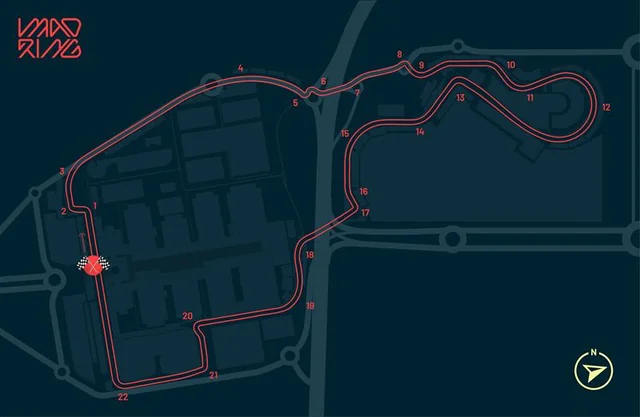
Formula 1 is heading to Madrid in 2026, and we now have a much clearer view of what to expect. The newly unveiled Madring layout presents an ambitious blend of permanent and street circuit design, weaving around the IFEMA convention center in Spain’s capital. While excitement is building, early reactions suggest that the circuit’s success will depend heavily on execution.
The Layout: Part Permanent Circuit, Part Urban Adventure
Spanning 5.474 km and featuring 57 laps, the Madring aims to be fast, technical, and visually striking. With an estimated lap time of around 1 minute 32 seconds and an average speed near 220 km/h, the course promises a faster profile than typical city circuits like Singapore or Las Vegas.
One of the biggest strengths of the Madring’s design lies in its sector diversity:
- Sector 1 and 2 are built for speed, with flowing corners and proper straight-line sections that should allow drivers to push their limits.
- Sector 3 slows the pace dramatically, becoming tight and technical, ideal for mistakes under pressure, but risky for overtaking opportunities.
Our analysis suggests that while the front half of the lap feels promising, the final sector risks creating a DRS train if the track isn’t sufficiently wide through the twistier portions. Without careful attention to these key areas, the circuit could fall into the same trap as previous “hybrid” street courses that struggled with follow-the-leader racing.
Will It Race Well? A Critical Look
From a racing dynamics standpoint, the Madring carries echoes of Valencia’s ill-fated street circuit from the early 2010s. The combination of modified streets and custom sections aims to offer more character than pure parking-lot layouts, but concerns remain.
Comparing the Madring to past experiments, the circuit’s integration of fast corners and meaningful straights gives it more potential than Miami’s somewhat awkward early years. However, the narrow width in parts of the final sector could severely limit overtaking unless modifications are made during the build.
In short:
- The straightaways and varied corner types are a positive step away from “Monaco but wider” clones.
- The average speed profile suggests it could be faster and racier than initial fears predicted.
- But the risk of a congested final sector is real, and could undo much of the good work if not carefully addressed.
If organizers can ensure sufficient width for wheel-to-wheel action, especially before the long straights, the Madring could become a standout on the modern calendar. If not, it risks being another high-gloss, low-impact event.
Carlos Sainz Kicks Off Madrid’s New Era
Madrid native Carlos Sainz has already thrown his weight behind the project, appearing at the groundbreaking ceremony this month. His involvement isn’t just ceremonial, it’s an important endorsement from one of Spain’s premier racing talents.
Given Sainz’s racer mentality and understanding of what makes a track enjoyable (and fair) for drivers, his early support offers a glimmer of hope that the Madring’s design won’t just cater to corporate spectacle but will prioritize racing quality as well.
It’s clear that Madrid’s organizers are aware of the pressure: fans expect better than the lukewarm debuts of some recent city circuits. Building a layout that drivers genuinely enjoy, and that creates real on-track drama, will be crucial to the Grand Prix’s long-term success.
Strategic Shift: Goodbye Barcelona?
Madrid’s arrival likely signals the end of Barcelona’s run as the host of the Spanish Grand Prix after 2025. While some fans lament losing one of the few remaining “classic” European circuits, this move fits the broader Formula 1 strategy: urban-centered races, glitzier marketing, and big-ticket global reach.
From a business perspective, Madrid makes perfect sense. From a racing purist’s perspective, the move feels bittersweet, but if the Madring delivers strong racing, history suggests that nostalgia will quickly give way to excitement.
Final Verdict: Cautious Optimism
The Madring has a chance to carve out a unique identity: fast sectors, real straights, technical challenges, and a stunning city backdrop. However, much depends on final build quality and careful management of overtaking zones.
If Madrid leans into its speed potential while avoiding the pitfalls of overly technical bottlenecks, it could become one of the more exciting new additions to the F1 calendar. If not, it risks becoming yet another cautionary tale of form over function.
As of now, we at F1natics are cautiously optimistic. The layout shows promise, the setting is fantastic, and with Sainz involved early, the right voices are being heard. But as always in Formula 1, seeing will be believing.
